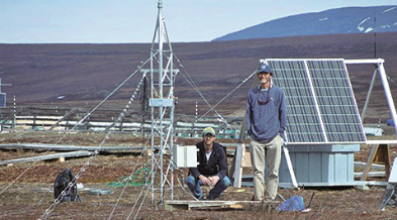CNR 4 on the North Slope of Alaska
Published: Thursday, December 5, 2013
Ecological research currently being conducted on the North Slope of Alaska has been enhanced via implementation of radiation measurements made by Kipp & Zonen products. Here, we employ CNR 4 Net Radiometers at four locations: Toolik Lake (68°37’15.78” N, 149°35’47.40” W) and Imnavait Creek (68°36’59.12” N, 149°18’22.69” W), Atqasuk (70°27'N, 157°24'W) and Barrow Alaska (71°18' N, 156°40' W).
This instrument is part of a suite of sensors on mobile platforms designed to examine Arctic ecological characteristics of vegetation through long-term observations within the Arctic Observation Network (AON) and the International Tundra Experiment (ITEX) established in the early 1990’s.
 We utilize the CNR 4 model at the North Slope locations so that we can analyze all incoming and outgoing long-wave and short-wave radiation among different vegetative communities including dry heath, moist acidic tundra, and shrub tundra, to name a few. At a fifth location, Thule Greenland (76°32' N, 68°49' W), we are using a CNR 2 in conjunction with a CMP 3 pyranometer.
We utilize the CNR 4 model at the North Slope locations so that we can analyze all incoming and outgoing long-wave and short-wave radiation among different vegetative communities including dry heath, moist acidic tundra, and shrub tundra, to name a few. At a fifth location, Thule Greenland (76°32' N, 68°49' W), we are using a CNR 2 in conjunction with a CMP 3 pyranometer.
Our daily scans span the Arctic growing season (May to September) enabling us to analyze phenomena occurring over seasonal, monthly, weekly, and daily time periods. These radiation measurements across the Arctic biome are critical for AON-ITEX in order to investigate both short-term and long-term energy, carbon, and water balance studies at the Earth’s surface.
We don’t only work in Alaska! We have also deployed a lightweight mobile sensor with a CNR 2 net radiometer and CMP 3 pyranometer system above the canopy of rainforest in Costa Rica. And two of our eddy covariance flux towers in the Everglades of Florida as well as the tower in Costa Rica use CNR 2’s. And in the Florida Everglades Wetlands we’re using a Kipp & Zonen Large Aperture Scintillometer (LAS) for sensible heat flux measurement.
Find out more about the work of the Florida International University Department of Biological Sciences at www.biology.fiu.edu.
By Steven F. Oberbauer, Ph.D. and Nathan C. Healey, Ph.D. of Florida International University Department of Biological Sciences, Miami.
See the tram powered International Tundra Experiment explained in below video interview bywww.FrontierScientists.com: